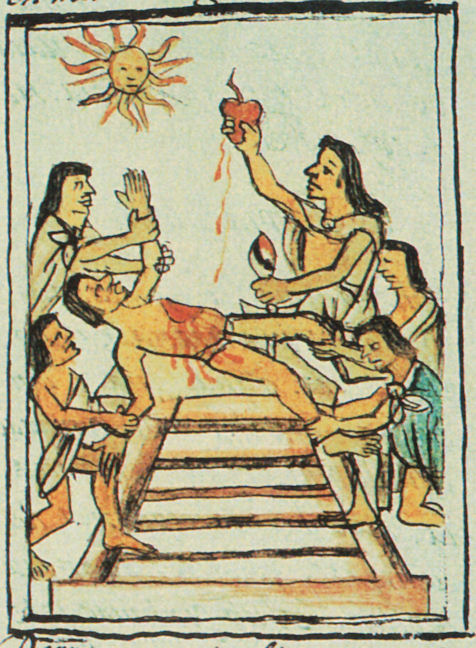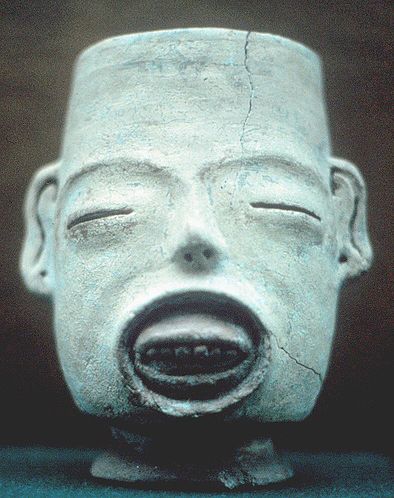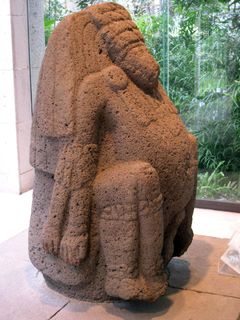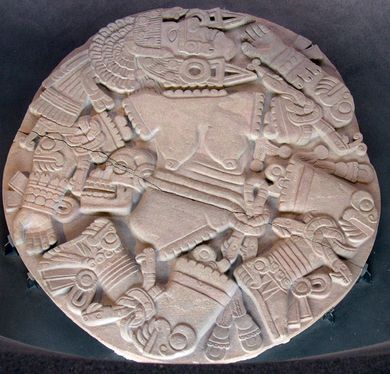
Justified as keeping the cosmos functioning, human sacrifice also created a reign of terror to sustain the political régime.
(Florentine Codex)
Content created: 2008-08-21
Part 13
Part 15

In general, conquest at a distance proved more challenging than conquest next door. There were the expectable logistic challenges of forcing armies to march long distances through mountain forests. But there was also the difficulty of transporting home the captured warriors so they could be sacrificed, especially if they were too badly injured to walk, or if supplies were too low to feed additional numbers. It became far easier to kill them on the spot and procure new captives closer to home.
To this end, Tlacahélel seems to have been the inventor of "flowery wars" (xochi-yaóyotl), battles conducted against other Nahua states with no military objective whatsoever, but with the "religious" goal of capturing thousands of young men to be sacrificed in ever larger rituals in honor of Huitzilo-póchtli as the patron of the régime.
One of the continuing enemies of the Aztecs was the state of Tlaxcállan, and Andrés de Tapia, author of an early collection of documents, quotes Moteuczóma II's reply when a Spanish soldier asked him why they did not assimilate Tlaxcállan, since conquest seemed potentially within the Aztec grasp. Moteuczóma said:
"We could easily do so, but then there would remain nowhere for the young men to train except far from here; and also, we wanted there to always be [nearby] people [for us] to sacrifice to our gods." (Quoted by Smith 2003: 171)


Moteuczóma may have been boasting, and probably the view from Tlaxcállan was a bit different. (More on Tlaxcállan.) But the remark makes it clear that Moteuczóma saw no compelling economic or defensive necessity for this conflict.
When the great drought came to an end in 1455 after a huge increase in human sacrifice, Tlacahélel could argue that the gods required a good supply of human blood, and he appears to have been determined that they should get it. It seems unlikely that very many people truly believed this "religious" interpretation. But whatever they believed, the flow of blood also would have had the effect of intimidating doubters and enemies of the régime. The most extensive human sacrifices took place atop the great pyramid dedicated Huitzilo-póchtli at Tenochtítlan. Other sacrifices were held at lesser temples throughout the Aztec sphere of influence.
Most of the underlying ideas associated with human sacrifice were not new. For example, beginning in 1458, the Aztecs held regular sacrifices to Xípe Tótec ("our flayed lord"), a southern Mexican god celebrated especially along the Gulf Coast and associated with the germination of young plants in the spring (Miller & Taube 1993:188). He had for hundreds of years been represented in sculpture as a figure wearing the skin of a flayed captive full of tiny cuts oozing blood like the sprouts of newly emerging plants. It appears that in pre-Aztec times, the spring fertility rites associated with Xípe Tótec involved the sacrifice of a human victim, who was tied up, suspended in the air, and shot with arrows, his falling blood representing life-bringing spring rain. When he had died, his skin, covered with slowly bleeding wounds, was then removed and worn by a priest as a living representation of the earth producing new life (Padden 1967: 34).
When the Aztecs undertook the celebration of Xípe Tótec the scale of the public killing expanded considerably, additional mythological associations linked him to the Aztec pantheon, and all segments of Aztec society were called upon to witness the event. (Diego Durán’s 1570 account of the Xípe Tótec festival is available on this web site. Link)
The ancient association of blood with life would have made it easy to see the sacrifice of one's own blood as a gift of life, as the donation of the most precious thing one had. Throughout Mesoamerica, back into the mists of time, people had engaged in "autosacrifice," cutting themselves with knives or sting-ray spines and offering the blood to the gods in various ways. And there was probably always some use of human sacrifice, both as the ultimate sacrifice and as a sanctimonious way to get rid of captive warriors (or the leaders or rival states). [Note 27]
Most writers tell us that "the Aztecs believed" that immense amounts of blood were needed in order to nourish the sun so that it would continue to rise, a view of Nahua belief that is widely held by the public today, perhaps in part due to the influence of lurid films. [Note 28] A far more skeptical position is taken by historian R.C. Padden, who sees the "nourishing the sun" motif as the cynical invention of Tlacahélel and his henchmen among the Mexica nobility —the pilipitin (singular: pilli)— seeking a philosophical justification for massive sacrifice that was actually aimed at holding the Mexica and their subjects in terror. Padden writes (1967: 34-37):
29. [Padden's note 30:] Durán, cap. xix. Most writers follow Alfonso Caso, La religión de los Aztecas and El pueblo del sol, in his assumption that the Mexican practice of human sacrifice stemmed from philosophical and religious convictions. It is obvious, however, that human sacrifice as a political instrument preceded by far its later philosophical and symbolic adornment. Also see L. Séjourné, Burning Water.Tlacaellel appears to have been working closely with learned mythologians in fabrication of a philosophical justification for the homicidal nature of domestic and imperial policies. Their efforts resulted in the well known "cosmic mission theory," according to which the world was in darkness until one of the gods created the sun by casting himself into a brazier of live coals. He rose again as the sun, but could not move across the heavens in daily journey without proper nourishment, which, it was determined, was a magical substance found only in the hearts and blood of men. It therefore became the divine mission of the Mexica to feed the sun, thereby guaranteeing daily continuation of the universe. Since the gods had sacrificed themselves in order to initiate the process, it was held that man must sacrifice himself in order to maintain it. It was now that the Pipiltin [lords] began to call themselves "People of the Sun." It is noteworthy that the blood that nourished the sun was also held to nourish Huitzilopochtli. [Note 29]
Padden argues that once this mythology had been worked out, the next step was to develop ritual trappings to fit with it, "the possibilities of which were virtually endless." He continues:
30. [Padden's note 32:] Códice Ramírez, 130, Durán caps. xxiii, xxxvi, passim; Codex Magliabecchi, 18r; Florentine Codex, Bk. IX, chap. ii.After this period of formulation, the sources indicate increasing refinement of sacrificial symbolism. Freshly drawn hearts are held aloft and offered to the sun; the victim is frequently stained red, the solar color; slowly he mounts the eastern staircase, like the rising sun, reaching the slab precisely at high noon; the blade falls and the sun gets a drink; the drained corpse is tumbled down the western side in sprawling emulation of the setting sun. …Whatever the mythologians made of it, Tlacaellel never lost sight of first principles: he seldom failed to use the Festival-of-the-Flayed-Ones and other sacrificial spectaculars to gain political ends. Not only were provincial lords made to attend, but the lords of cities and states yet independent were enjoined to come, with the avowed purpose of intimidating them and gaining their submission. [Note 30]
If the Aztec and Spanish chroniclers are to be believed, at no time in human history was human sacrifice practiced on the scale at which it was carried out at Tenochtítlan. [Note 31] Tlacahélel may really have believed in the need for a great flow of human blood to feed the gods. But he could hardly have failed to note that the visible destruction of warriors and captives from rival states on the altars of the land was likely to have a deterrent effect on dissent.


At the foot of Huitzilo-póchtli's great temple, slightly off center so as not to interfere with the main staircase, there was a huge stone displaying an image of the severed limbs of the god Huitzilo-póchtli's sister, Coyol-xáuhqui ("she of the bells on her cheek"). The story went that from inside his sleeping mother's womb, the god heard his sister and her brothers conspiring to kill their mother before he could be born because of the shame caused by her pregnancy.
Enraged, he burst forth from the womb, grabbed a knife, chopped his sister to bits, and chased her brothers so far away that they turned into stars. Thus perish those who would attack Huitzilo-póchtli. (A version of this myth is available on this web site. Link)
The Coyol-xáuhqui stone, still today, fairly screams the message to all who see it. Each time the temple was enlarged and rebuilt, a new Coyol-xáuhqui stone was created. The latest, about nine feet across, is correctly regarded as one of the greatest masterpieces of Aztec sculpture.
| « Part 13 |
Contents Glossary, Bibliography | Part 15 » |